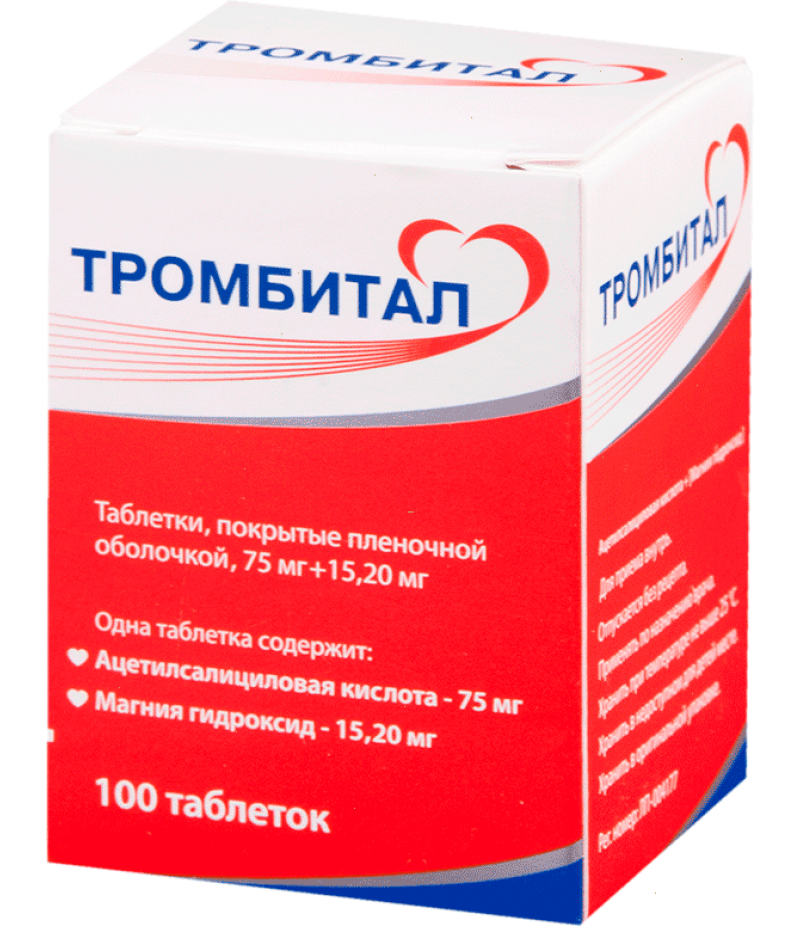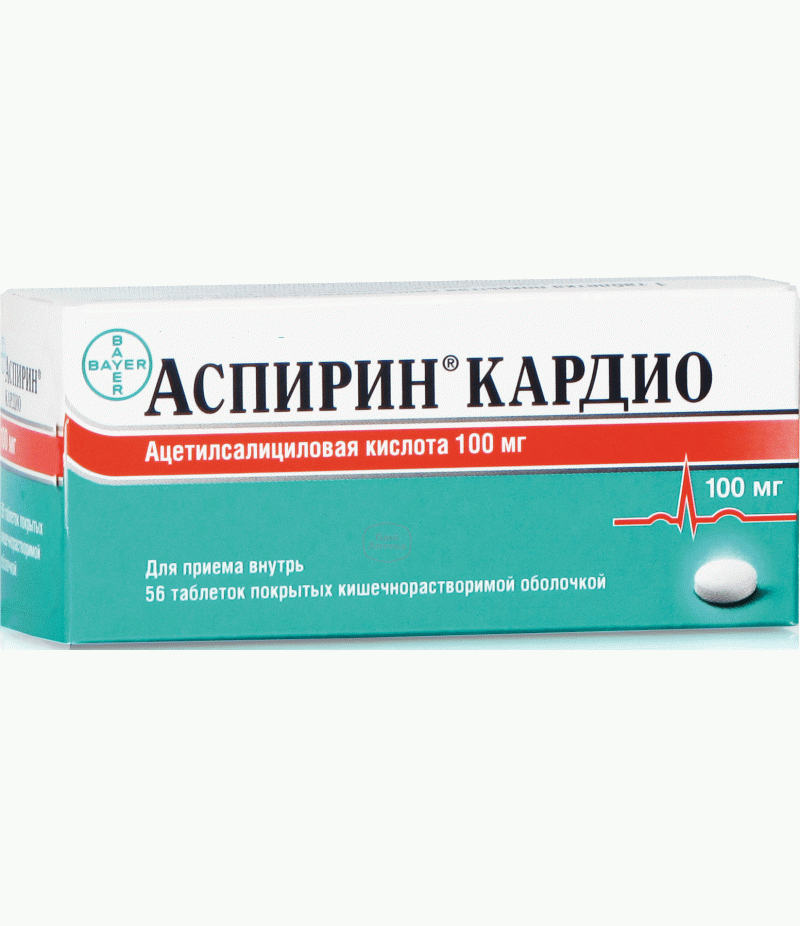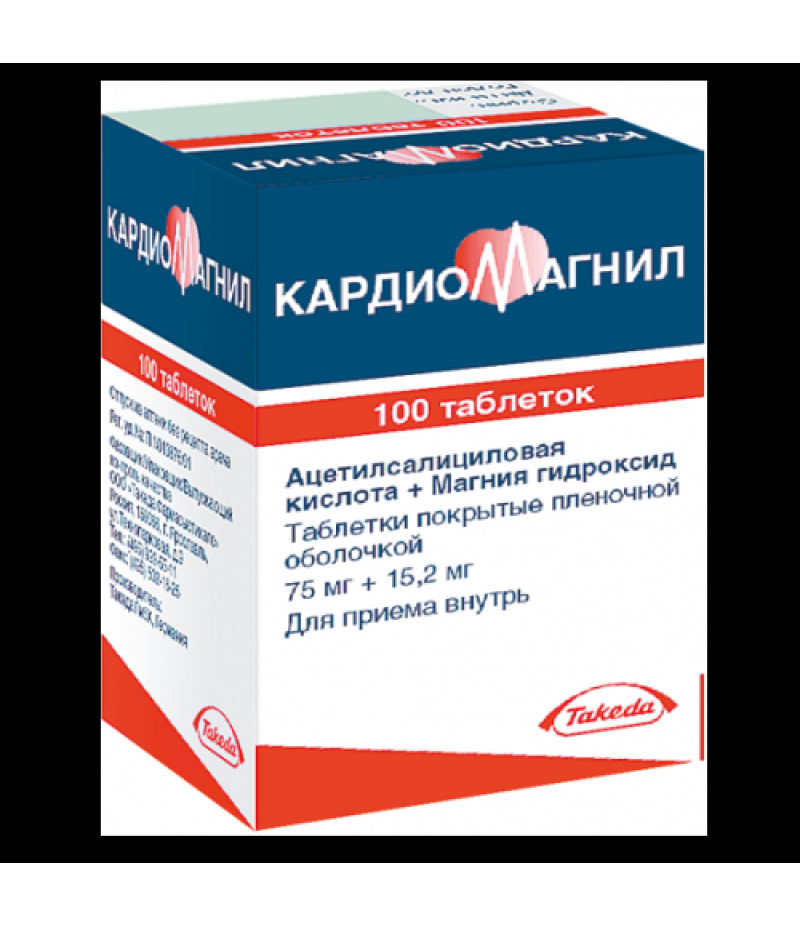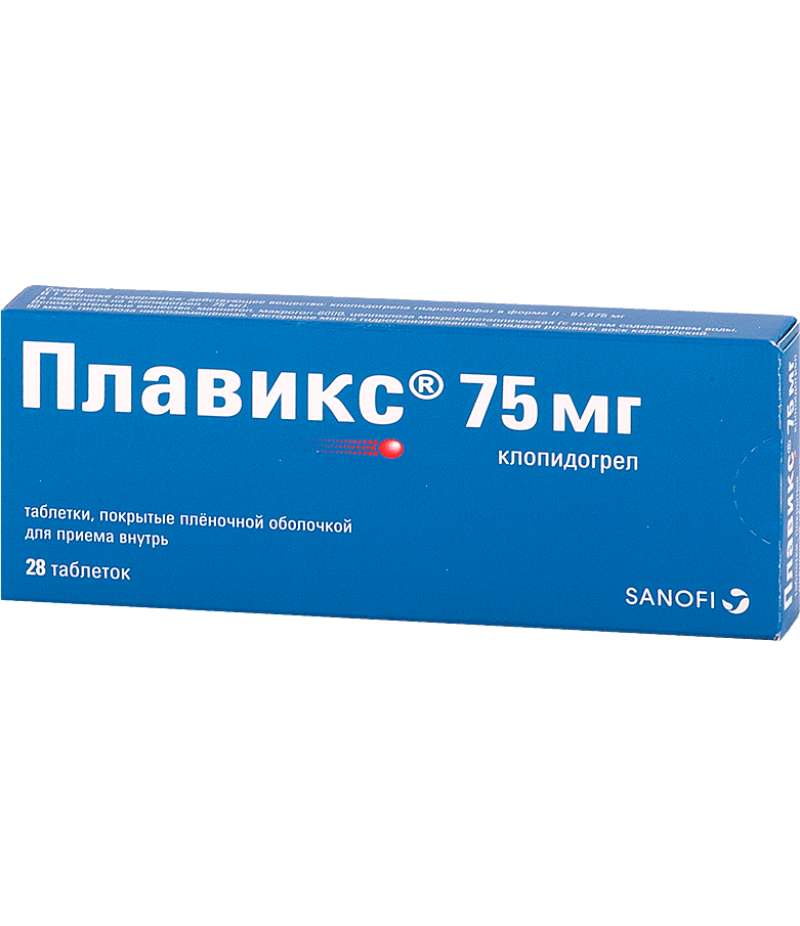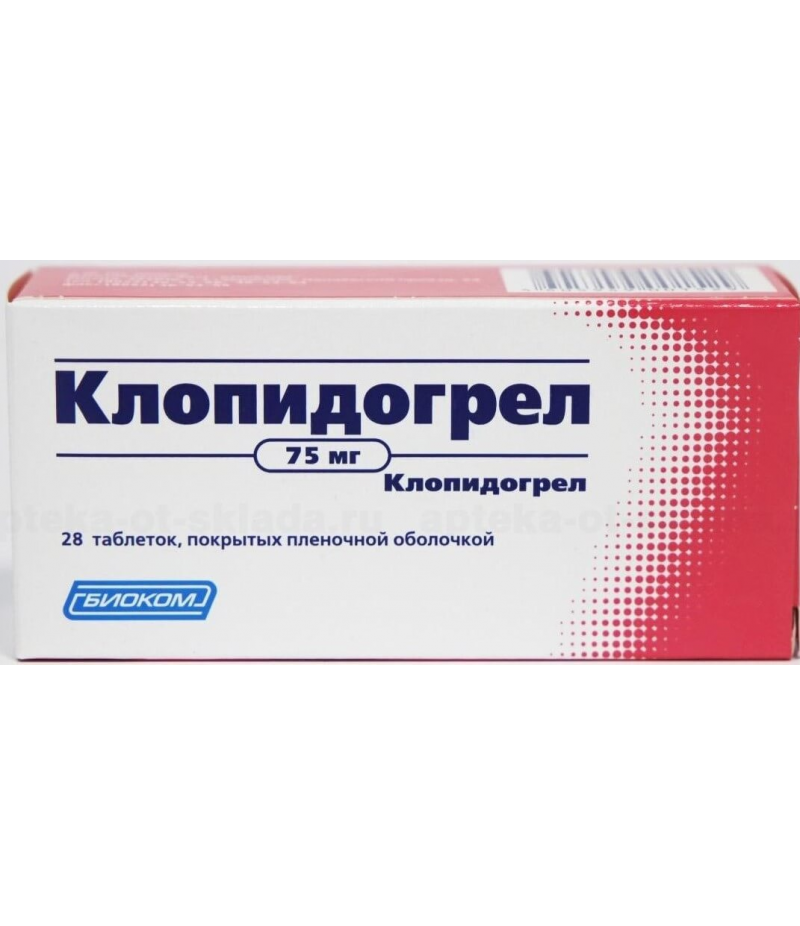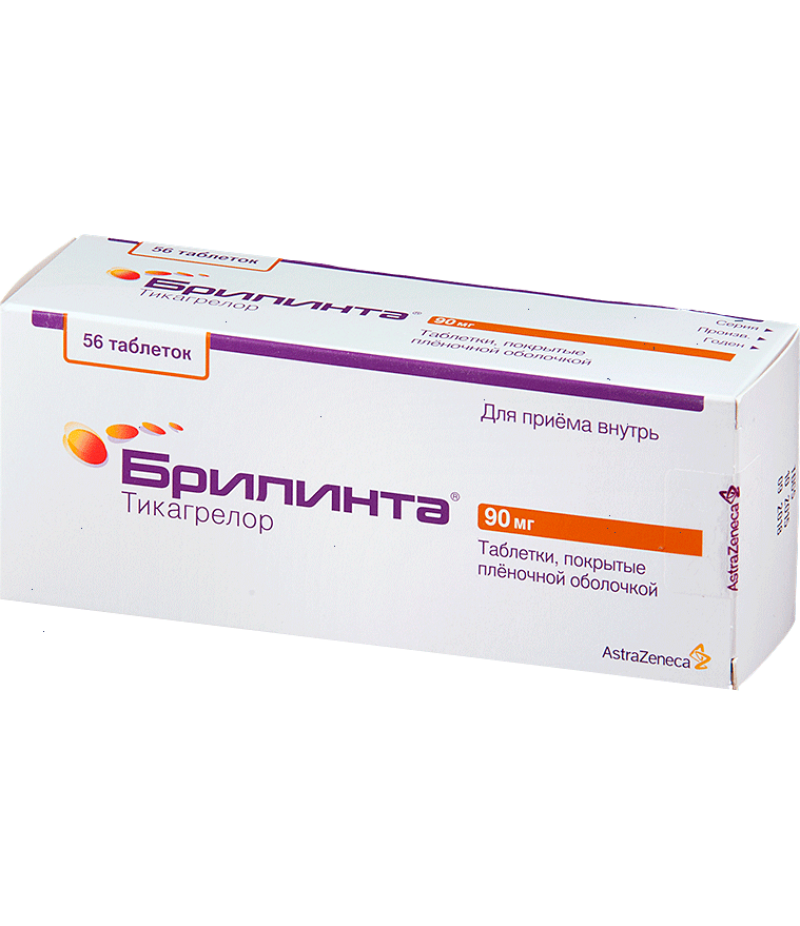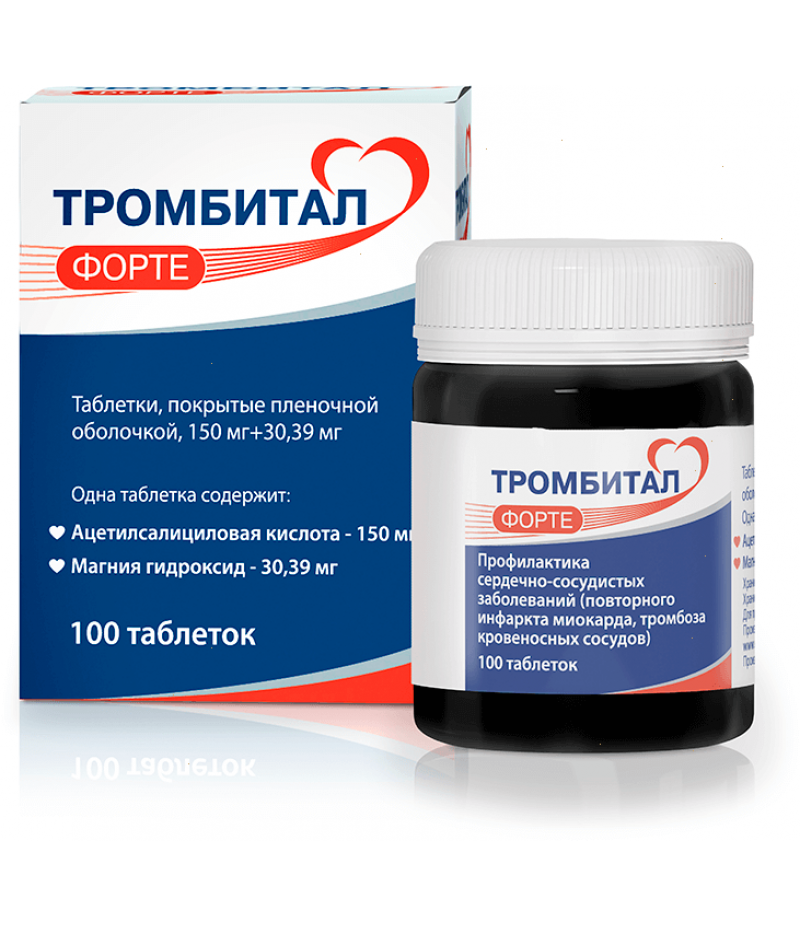Trombital tabs 75mg +15.2mg #100
- $8.75
- 3 or more $8.59
- Availability:In Stock
Trombital instructionYou can buy Trombital hereCompositionActive ingredients: acetylsalicylic acid - 75.00 mg / 150.00 mg, magnesium hydroxide - 15.20 mg / 30.39 mg.Excipients: microcrystalline cellulose, corn starch, potato starc..
Tags: tabs
Trombital instruction
You can buy Trombital here
Composition
Active ingredients: acetylsalicylic acid - 75.00 mg / 150.00 mg, magnesium hydroxide - 15.20 mg / 30.39 mg.
Excipients: microcrystalline cellulose, corn starch, potato starch, magnesium stearate.
Shell: hypromellose (hydroxypropyl methylcellulose 15 cP), macrogol (polyglycol 4000), talc.
Packaging - 100 pieces.
pharmachologic effect
Reduces aggregation, platelet adhesion and thrombus formation by suppressing the synthesis of thromboxane A2 in platelets. Antiplatelet effect persists for 7 days after a single dose (more pronounced in men than in women). Acetylsalicylic acid reduces mortality and the risk of myocardial infarction in unstable angina, is effective in primary prevention of diseases of the cardiovascular system, especially myocardial infarction in men older than 40 years, and in secondary prevention of myocardial infarction.
Suppresses the synthesis of prothrombin in the liver and increases the prothrombin time. Increases plasma fibrinolytic activity and reduces the concentration of vitamin-K-dependent coagulation factors (II, VII, IX, X). Increases the risk of hemorrhagic complications during surgical interventions, increases the risk of bleeding during therapy with anticoagulants.
Acetylsalicylic acid in high doses also has anti-inflammatory, analgesic, antipyretic effect.
In high doses, acetylsalicylic acid stimulates the excretion of uric acid (violates its reabsorption in the renal tubules).
Cyclo-oxygenase-1 blockade in the gastric mucosa leads to inhibition of gastroprotective prostaglandins, which may result in ulceration of the mucous membrane and subsequent bleeding.
Magnesium hydroxide, which is part of Trombital, protects the mucous membrane of the gastrointestinal tract from the effects of acetylsalicylic acid.
Trombital indications
Primary prevention of cardiovascular diseases such as thrombosis and acute heart failure in the presence of risk factors (for example, diabetes mellitus, hyperlipidemia, arterial hypertension, obesity, smoking, old age).
Prevention of recurrent myocardial infarction and thrombosis of blood vessels.
Prevention of thromboembolism after surgical interventions on the vessels (coronary artery bypass graft, percutaneous transluminal coronary angioplasty).
Unstable stenocardia.
Contraindications
Hypersensitivity to acetylsalicylic acid, drug excipients and other nonsteroidal anti-inflammatory drugs (NSAIDs);
cerebral hemorrhage;
bleeding tendency (vitamin K deficiency, thrombocytopenia, hemorrhagic diathesis);
erosive and ulcerative lesions of the gastrointestinal tract (in the acute phase);
gastrointestinal bleeding;
bronchial asthma induced by salicylates and other NSAIDs;
a combination of bronchial asthma, recurrent nasal polyposis, and paranasal sinuses with acetylsalicylic acid intolerance;
simultaneous administration of methotrexate at a dose of 15 mg per week or more;
pregnancy (I and III trimesters);
lactation period;
deficiency of glucose-6-phosphate dehydrogenase;
severe renal failure (creatinine clearance (CC) less than 30 ml / min);
severe hepatic impairment (class B and C on the Child-Pugh scale);
chronic heart failure III and IV functional class according to the NYHA classification;
children's age up to 18 years.
Carefully
In gout, hyperuricemia, as well as acetylsalicylic acid in small doses reduces the excretion of uric acid.
With a history of ulcerative lesions of the gastrointestinal tract or gastrointestinal bleeding.
When liver failure (class A on a scale of Child-Pugh).
With renal failure (CC more than 30 ml / min).
With bronchial asthma, chronic diseases of the respiratory system, hay fever, nasal polyposis, allergic conditions, drug allergies.
With diabetes.
In elderly patients.
In the II trimester of pregnancy.
With the intended surgical intervention (including minor, for example, tooth extraction), because acetylsalicylic acid may cause a tendency to develop bleeding within a few days after taking Trombital.
When taken simultaneously with the following drugs (see the section "Interaction with other drugs"):
with methotrexate at a dose of less than 15 mg per week;
with anticoagulants, thrombolytic or antiplatelet agents;
with NSAIDs and salicylic acid derivatives in high doses;
with digoxin;
with oral hypoglycemic agents (sulfonylurea derivatives) and insulin;
with valproic acid;
with alcohol (alcoholic beverages in particular);
with selective serotonin reuptake inhibitors;
with ibuprofen,
with narcotic analgesics,
with sulfonamides (including co-trimoxazole),
with carbonic anhydrase inhibitors (acetazolamide),
with lithium
with systemic glucocorticosteroids.
Dosage and administration
Trombital is taken orally, once a day, drinking water. The tablet can be swallowed whole, chew or pre-grind.
Trombital is intended for long-term use. The duration of treatment and the dose of the drug Trombital is determined by the doctor.
Use Trombital only according to the indications, the method of application and in those doses that are specified in the instructions.
Use during pregnancy and lactation
Trombital is contraindicated for use in I and III trimesters of pregnancy, because has a teratogenic effect - when applied in the first trimester of pregnancy, the upper palate splits in the fetus; in the third trimester, it causes inhibition of labor activity (suppression of prostaglandin synthesis), premature closure of the ductus arteriosus, hyperplasia of the pulmonary vessels and hypertension in the small circulation.
Taking Trombital in the II trimester is possible only if the potential benefit to the mother exceeds the risk to the fetus.
Acetylsalicylic acid and its metabolites pass into breast milk. At the time of treatment, breastfeeding should be discontinued.
Side effects of Trombital
The following adverse events are distributed by frequency of occurrence in accordance with the following gradation: very often (with a frequency of more than 1/10), often (with a frequency of at least 1/100, but less than 1/10), infrequently (with a frequency of at least 1 / 1000, but less than 1/100), rarely (with a frequency of at least 1/10000, but less than 1/1000), very rarely (with a frequency of less than 1/10000), including individual messages.
On the part of the blood and lymphatic system: very often - increased bleeding (hematomas, nosebleeds, bleeding gums, bleeding from the urogenital tract); rarely - anemia; very rarely - hypoprothrombinemia, thrombocytopenia, neutropenia, aplastic anemia, eosinophilia, agranulocytosis; unknown frequency - leukopenia. There are reports of serious cases of bleeding, which include gastrointestinal bleeding and bleeding in the brain (especially in patients with arterial hypertension who have not reached the target blood pressure numbers and / or are receiving concomitant anticoagulant therapy), which in some cases may be life-threatening character. Bleeding can lead to the development of acute or chronic post-hemorrhagic / iron deficiency anemia (for example, due to latent bleeding) with relevant clinical and laboratory signs and symptoms (asthenia, pallor, hypoperfusion). There are reports of hemolysis and hemolytic anemia in patients with severe glucose-6-phosphate dehydrogenase deficiency.
Allergic reactions: often - urticaria, angioedema; infrequently - anaphylactic reactions, including angioedema; unknown frequency - skin rash, itching, rhinitis, swelling of the nasal mucosa, cardio-respiratory distress syndrome, as well as severe reactions, including anaphylactic shock.
From the nervous system: often - headache, insomnia; infrequently - dizziness, drowsiness; rarely - tinnitus, intracerebral hemorrhage; unknown frequency - hearing loss, which may be a sign of overdose of the drug (see "Overdose").
The respiratory system, chest organs and mediastinum: often - bronchospasm.
From the gastrointestinal tract: very often - heartburn; often - nausea, vomiting; infrequently - pain in the abdomen, ulcers of the mucous membrane of the stomach and duodenum, including perforative (rare), gastrointestinal bleeding; rarely, increased activity of liver enzymes; very rarely - stomatitis, esophagitis, erosive lesions of the upper gastrointestinal tract, stricture, irritable bowel syndrome, colitis; unknown frequency - loss of appetite, diarrhea.
On the part of the urinary system: unknown frequency - impaired renal function and acute renal failure.
If you have side effects that are listed in the instructions, or they get worse, or you notice any other side effects that are not listed in the instructions, tell your doctor about it.
special instructions
Trombital should be used as prescribed by a doctor.
Acetylsalicylic acid can provoke a bronchospasm, and also cause attacks of bronchial asthma and other hypersensitivity reactions. Risk factors are a history of bronchial asthma, hay fever, nasal polyposis, chronic diseases of the respiratory system, and allergic reactions to other drugs (for example, skin reactions, itching, urticaria). Acetylsalicylic acid can cause bleeding of varying severity during and after surgical interventions. A few days before the planned surgical intervention, the risk of bleeding should be assessed compared to the risk of ischemic complications in patients taking low doses of acetylsalicylic acid. If the risk of bleeding is significant, acetylsalicylic acid should be temporarily stopped. The combination of acetylsalicylic acid with anticoagulants, thrombolytic agents and antiplatelet drugs is associated with an increased risk of bleeding.
Acetylsalicylic acid in low doses can trigger the development of gout in susceptible patients (with reduced uric acid excretion). The combination of acetylsalicylic acid with methotrexate is accompanied by an increased incidence of side effects from the blood-forming organs.
High doses of acetylsalicylic acid have a hypoglycemic effect, which must be borne in mind when prescribing it to patients with diabetes mellitus who receive hypoglycemic agents for oral administration and insulin.
When combined use of systemic glucocorticosteroids and salicylates should be remembered that during treatment the concentration of salicylates in the blood is reduced, and after the abolition of systemic glucocorticosteroids may overdose of salicylates.
The combination of acetylsalicylic acid and ibuprofen is not recommended in patients with an increased risk of cardiovascular diseases: while using ibuprofen, there is a decrease in the antiaggregant effect of acetylsalicylic acid in doses up to 300 mg, which leads to a decrease in cardioprotective effects of acetylsalicylic acid.
Increasing the dose of acetylsalicylic acid over therapeutic doses is associated with the risk of gastrointestinal bleeding.
With long-term intake of low doses of acetylsalicylic acid as an antiplatelet therapy, care must be taken in elderly patients because of the risk of developing gastrointestinal bleeding.
While taking acetylsalicylic acid with alcohol increases the risk of damage to the mucous membrane of the gastrointestinal tract and lengthening the time of bleeding.
With prolonged use of Trombital should be periodically done a general blood test and stool test for occult blood.
During the period of treatment with acetylsalicylic acid preparations, care must be taken when driving vehicles and practicing potentially hazardous activities that require increased concentration of attention and speed of psychomotor reactions.
Interaction
With simultaneous use of acetylsalicylic acid enhances the effect of the following drugs:
methotrexate by reducing renal clearance and displacing it from the connection with proteins, the combination of acetylsalicylic acid with methotrexate is accompanied by an increased incidence of side effects from the blood-forming organs;
narcotic analgesics, other NSAIDs;
heparin and indirect anticoagulants due to dysfunction of platelets and the displacement of indirect anticoagulants due to the blood plasma proteins;
thrombolytic, antiplatelet and anticoagulant drugs (ticlopidine);
digoxin due to a decrease in its renal excretion;
hypoglycemic agents for oral administration (sulfonylurea derivatives) and insulin due to the hypoglycemic properties of acetylsalicylic acid itself in high doses and forcing out sulfonylurea derivatives from their association with plasma proteins;
valproic acid due to its displacement from the association with plasma proteins. The simultaneous use of acetylsalicylic acid with ibuprofen leads to a decrease in the cardioprotective effects of acetylsalicylic acid.
The combination of acetylsalicylic acid with anticoagulants, thrombolytics and antiplatelet agents is accompanied by an increased risk of bleeding. Simultaneous use with acetylsalicylic acid increases the concentration of barbiturates and lithium salts in the blood plasma.
By increasing the elimination of salicylates, systemic glucocorticosteroids weaken their action.
Glucocorticosteroids, ethanol and ethanol-containing drugs increase the negative impact on the mucous membrane of the gastrointestinal tract and increase the risk of gastrointestinal bleeding.
At the same time taking acetylsalicylic acid with ethanol there is an increase in the toxic effect of ethanol on the central nervous system. Acetylsalicylic acid reduces the effect of uricosuric drugs - benzbromaron, probenicid (reduction urikozuricheskogo effect due to competitive suppressing renal tubular excretion of uric acid), angiotensin converting enzyme inhibitors (marked dose-dependent decrease in glomerular filtration rate by inhibiting prostaglandins possessing vasodilating action, and accordingly attenuation of the hypotensive action), diuretics (when used together with acetylsalicylo high-dose acid boosts marked decrease in glomerular filtration rate as a result of decreased prostaglandin synthesis in the kidney) Antacids and colestyramine reduce the absorption of acetylsalicylic acid.
Overdose
May occur after a single dose of a large dose or with prolonged use of Trombital. If a single dose of acetylsalicylic acid is less than 150 mg / kg, acute poisoning is considered mild, 150-300 mg / kg is of moderate severity, and when used in higher doses, it is heavy.
Mild to moderate overdose symptoms: dizziness, tinnitus, hearing loss, blurred vision, increased sweating, nausea, vomiting, headache, confusion, tachypnea, hyperventilation, respiratory alkalosis.
Treatment: provocation of vomiting, repeated administration of activated carbon, forced alkaline diuresis, restoration of water-electrolyte balance and acid-base state.
Symptoms of overdose moderate to severe:
respiratory alkalosis with compensatory metabolic acidosis;
hyperpyrexia (extremely high body temperature);
respiratory disorders: hyperventilation, non-cardiogenic pulmonary edema, respiratory depression, asphyxia;
disorders of the cardiovascular system: cardiac arrhythmias, lowering blood pressure, cardiac depression, collapse;
violations of water and electrolyte balance: dehydration, impaired renal function from oliguria until the development of renal failure, characterized by hypokalemia, hypernatremia, hyponatremia;
glucose metabolism disorders: hyperglycemia, hypoglycemia (especially in children), ketoacidosis;
tinnitus, deafness;
gastrointestinal bleeding;
hematological disorders: from inhibition of platelet aggregation to coagulopathy, prolongation of prothrombin time, hypoprothrombinemia;
neurological disorders: toxic encephalopathy and depression of the central nervous system function (drowsiness, confusion, coma, convulsions).
Treatment: immediate hospitalization in specialized departments for emergency treatment - gastric lavage, repeated intake of activated carbon and laxatives, alkalization of urine (indicated with salicylates above 500 mg / l, provided by intravenous infusion of sodium bicarbonate - 88 meq in 1 l of 5% glucose solution , at a rate of 10-15 ml / kg / h), the restoration of circulating blood volume and the induction of diuresis (achieved by the introduction of sodium bicarbonate in the same dose and dilution, repeat 2-3 times); It should be borne in mind that intensive fluid infusion in elderly patients can lead to pulmonary edema. The use of acetozolamide for alkalization of urine is not recommended (it can cause acidemia and increase the toxic effect of salicylates). When conducting alkaline diuresis, it is necessary to achieve pH values between 7.5 and 8. Hemodialysis is indicated when the level of salicylates in the blood plasma is more than 1000 mg / l, and in patients with chronic poisoning - 500 mg / l and lower when indicated (refractory acidosis, progressive deterioration, severe damage to the central nervous system, pulmonary edema, and renal failure). In pulmonary edema, artificial ventilation of the lungs with a mixture enriched with oxygen is shown in positive pressure at the end of expiration; Hyperventilation and osmotic diuresis are used to treat brain edema. The highest risk of developing chronic intoxication is observed in the elderly when taking more than 100 mg / kg / day for several days. In children and elderly patients, the initial signs of salicilism (nausea, vomiting, tinnitus, blurred vision, dizziness, headache, general malaise) are not always noticeable, therefore it is advisable to periodically determine the content of salicylates in the blood plasma.
Storage conditions
Shelf life - 2 years.
At a temperature not higher than 25 ° С.
Terms of sell
You can buy Trombital without a prescription.

